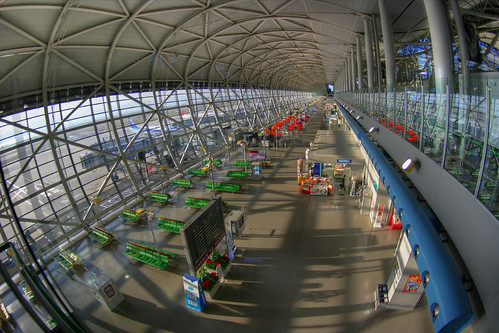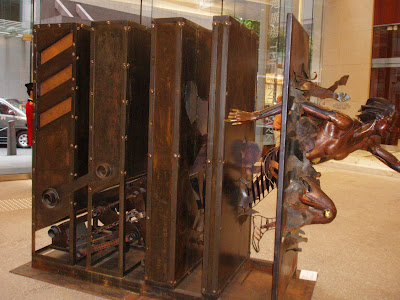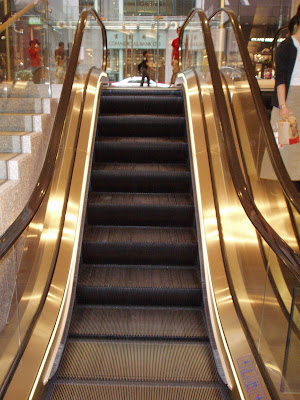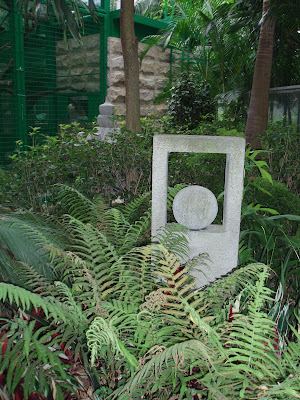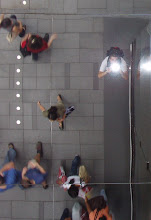Shinkansen = Bullet Train.
Hiroshima = "wide island" - or one of two cities that got A-Bombed in WWII.
Miyajima = Shrine Island.
My aunt and I started off the day on Saturday with an early rise to catch the Shinkansen to Hiroshima. They named the train very accurately - and as cliche as it sounds, we were flying along at mind-blowing speed with no sensory information other than sight to indicate how fast we were moving. A few times I tried to get a better look at things that caught my eye, only to see them zip out of view by the time I turned my head. I did manage to get some shots that gave me a sense of what Japan was like in terms of geography and urbanization.

Japan is much more flat than I had imagined. But, like Hong Kong, they still find it easier to build out into open water than up the side of a mountain. People here also like to live in standardized situations. There are no expensive "Ocean view condos" or Beverly Hills-style houses on the hill. People here seem to be somewhat reserved and shy - happy to live in a nice neighborhood like everyone else.


Unfortunately, given the absurd speed of the Shinkansen, I often ended up with photos of...wall...wall...blur...wall...blur...etc.
I never expected that Japan's rail system would be so complicated. The entire system seems to be comprised of a whole bunch of little private companies each with its own agenda, name, trains, and operating methods. I'm very glad I had a guide (Thanks a bundle Carolyn!) There is also no "whole system" fare solution as there is in Hong Kong with the Octopus Card. Japan is alone in my perception of the world in the sense that it is made up of cities with what seems like almost no space between. The railways all blend together in a way that I didn't expect and cannot compare with any other place in the world. The DC Metro is only meant for the DC Metropolitan Area, and the Hong Kong railway doesn't really connect to anything but longer distance trains that go to the border with China. Japan is really something different - as you can see below. Keep in mind that this is only a representation of Osaka, Kansai, Himeji, Kobe, and a few other towns/cities. This area is similar to the regions of Northern VA, Washington, Silver Spring, and Baltimore etc. in the sense of distances and urbanization. However, the blurring between city lines and time/distance ratios made this whole region seem much smaller.


I was able to catch a fairly nice example of graphic design, a-la DC metro Map. I mean that things are not drawn to scale or using the correct proportions, but the message is no less clear. The recognizable aspects of the trains, their "faces" as it were are each a little bit different, but different enough for Japanese to know the difference. Also, the train cars are not nearly as stumpy as they appear here, but the number of cars is much more important to travelers than their shape on a sign. It is also made clear which stairway to use to get oneself closest to the correct car on any specific train.
 .
.This is not a Shinkansen, but rather a more local train. Shinkansens operate like Amtrak in the US: only a few stops in each state - mostly for going really far without having to fly or drive. They stop at each major city, and cut travel times dramatically. The middle grade trains, like the one above are like Greyhound buses. They go from urban center to urban center, but you will probably need to figure out a way to get to the final destination yourself. This is where the local trains, light rails, and public buses come in. By using some combination of the three, one can get from within a few blocks of "Point A" to within a few blocks of "Point B".

The street cars are also really interesting here. You enter the vehicle for free and pay your fare when you "disembark" or as we Americans say "get off". Buses are the same way. I'm used to paying when boarding - entry fee style.


Upon arriving in Hiroshima, which would have likely blown away any preconceptions I had been foolish enough to hold , we hopped on a streetcar and made our way to the "A-Bomb Dome" one of the few buildings to survive the attack the marked the beginning of the end of the war with Japan. This was essentially a city center building that was used as an information center for businesses, an office for some of the city's services, and various other things over the years. Its dome was blown away in the blast, but its strong, solid walls and iron reinforcement for the dome were able to survive. Most experts attribute its survival to the fact that the blast's force was directed mostly downward and not across the structure.

Interestingly, this symbol of tragedy and devastation has had its image reinvented to that of a monument to peace. In this way, it has drawn in enough funds from wealthy donors to ensure that it will never fall down.

It's hard to believe that the A-Bomb Dome (left side of frame) is now among the shortest and smallest buildings in the city. People were rebuilding Hiroshima almost as soon as they stopped looking for wounded and dying.

Unfortunately, I visited the peace memorial park (below) before I entered the A-Bomb museum, so it didn't have quite the same impact that it should have had, but from an aesthetic standpoint, it is stunning. It is a very wide, flat, open, and uncluttered space - unheard of in most Japanese cities. The intense quiet that dominates this park is also surprisingly spooky.

Inside the museum were stories, photos, artifacts, and videos that really hit me hard. I thought I knew the story of the A-Bomb but it was much more deep, touching, and disturbing than I thought. I felt very lucky to even be walking around Hiroshima as an American, considering that there are still people walking the same streets having survived the bombing or lost loved ones to it.
In the foreground are a couple of lumps of coins that were fused together from the intense heat generated by the blast. The coins that have holes in the center make for a conveniently threaded bunch of money.

A couple of glass bottles that were melted into distorted silhouettes of their former selves by heat.

This next story speaks for itself. I am just a messenger. (click for a bigger image)


Below is a small-scale model of what was left of Hiroshima's buildings after the bomb detonated. The few that survived were built of concrete reinforced with iron. But that was probably not enough, since there were other similar buildings around that were obliterated. It is probably due in part to the fact that these buildings were beneath the epicenter of the explosion meaning that the blast energy compressed them, as opposed to shearing or shoving them off of their foundations. Japan's main method of construction then was wood and paper - essentially kindling. Even if the buildings were able to withstand the force of the bomb, they were burned like everything else all within one day of the bombing.

The dark spot in the center is a shadow cast by a ball hanging above that represents how big and high the fireball would have been just after it detonated.
After we finished our tour of the museum, we walked to this bridge, shaped like a "T" that the American bomber used as a target to drop the atomic bomb on Hiroshima. It detonated in the air only a few hundred meters to the southeast (I think).

After we wrapped up our tour of the A-Bomb Dome, The Museum and the park, we hopped a streetcar to the southwest side of the city to hop a ferry to Miyajima. After such a heavy-hitting morning, the general beauty and serenity of the island and the shrine were a welcome change.
At the end of the line we got out of the streetcar and looked around to find the ferry over to the island. It reminded me of Hong Kong and I realized how fortunate I was to be able to associate anything with the unique and incredible experiences I've had in Hong Kong.

The island has the kind of look of unspoiled beauty that I associate with things like "Jurassic Park, Lord of the Rings, Planet Earth and Braveheart" There was an air of beauty that transcended prettiness and nature. Maybe it was the fact that all of the vegetation was of a different variety than what I'm used to seeing in America and Hong Kong. The trees, grass, birds, and even the deer (below) are all just a little different, but enough to make me stand up and take notice.

On the ferry ride over, I caught a hint of English saying something about tame deer and taking care of passports and children so they are not harmed by the deer. It seemed like I was missing some information so I disregarded it but sure enough, there were cute little hungry deer wandering around the ferry terminal looking and sniffing for handouts. One even followed me for over a block before it came to the conclusion that I was not worth the trouble.

I thought that this was the perfect way to depict the modern impact on the old, classic beauty of the island. Even clouds look nice here, but ferries still do not.

The tide was about as low as it gets when we arrived at the island to walk through the shrine, which meant that the usual water lapping under the planks of the floor or rising up to meet the base of the torii, the thing above which looks like, and also literally means, a bird perch, were not present, but fortunately I was also able to get up close and see the bright colors and precise construction more clearly.

Pagodas come in all sorts of "flavors" around here. From basic old weathered wood to Day-Glo orange and white. I am sure that there is some reason for it, but I have yet to learn what that may be.
To the left of the neon orange pagoda is a shrine or temple (I do not yet know the difference) that is hundred of years old, if I remember correctly, and looks the part.


Sure the glass of the Bank of China Tower has a certain look, as does a sunset at the beach, but I personally feel that both pale in comparison to the way this majestic structure stands serenely on a hillside on a quiet island south of Hiroshima. It has withstood earthquakes, bombings, the A-Bomb, and probably countless other trials over its lifetime.

The wood looks very old in both its construction method and patina. I'd bet that all the nails used in this structure's completion would fit into one surprisingly small bucket. The Japanese are champions of precision engineering, and absurdly precise fitting in construction - both of which can eliminate the need for nails entirely.

The actual shrine is finished in the same colors as the neon pagoda, but there is enough raw wood to offset the intense orange a little and make it easier on the eyes.

The whole shrine is built on short stilts that allow it to stand a few inches above the surface of the water at high tide, creating what I imagine is a stunning reflection that dances with the colors and shapes of the shrine's columns, as well as the mountains surrounding the shrine grounds.

It is a non-issue for me to be unable to read the words, because I am sure that they are as impressive and beautiful as everything else that is associated with the shrine. The views, the sounds, the colors, the construction, and everything else that can't be put into words.

It is customary to wash one's hands and mouth with the pure water at the Shrine's entrance before entering so as to be pure before the spirit(s?). That's all well and good but the water was probably covered in a thin sheet of ice that morning considering the amount of snow on the roof of the shrine.
I think these shots clearly depict my early understanding of the Japanese people's attention to and appreciation of detail (as I spend more time here, I find myself noticing details in more and more situations). Not only are the all the faces of the tiles done in a beautiful finish and pattern, but the crispness and clarity of the pattern and details really impressed me. (The quality of these shots is pretty poor, so look for more to be posted in the near future)



We then hopped the ferry to the mainland under a beautiful late-day sun, we went home, and relaxed. I know that I was emotionally and physically drained after such a long and interesting day. I imagine that my aunt was as well.

